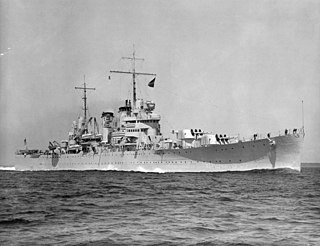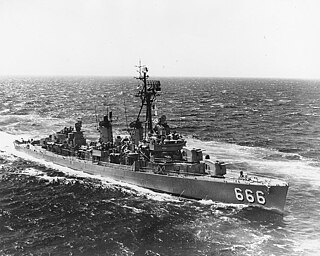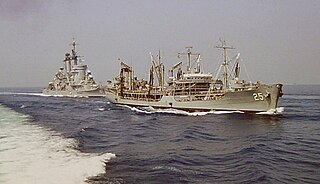
USS Boise (CL-47) was a light cruiser of the Brooklyn class in the United States Navy. The cruiser was named for Boise, the capital city of the state of Idaho. Commissioned in 1938, she saw extensive service during World War II, taking part in fighting in the Mediterranean and Pacific theaters. Following the war the ship was decommissioned in 1946 and lay idle until sold to Argentina in 1951. Renamed Nueve de Julio, the ship remained in service with the Argentinian Navy until 1978, after which she was taken to Brownsville, Texas and scrapped in 1983.

Clifton Albert Frederick "Ziggy" Sprague was a World War II–era officer in the United States Navy.

USS Douglas H. Fox (DD-779) was an Allen M. Sumner-class destroyer of the United States Navy.

USS Lamberton (DD-119)/(DMS-2) was a Wickes-class destroyer in the United States Navy in commission from 1918 to 1922 and from 1930 to 1946. She saw service during World War II. She was the only ship named for Benjamin P. Lamberton, a rear admiral who served with Admiral Dewey in the Battle of Manila Bay in 1898 during the Spanish–American War.

USS S-21 (SS-126) was a first-group S-class submarine of the United States Navy in commission from 1921 to 1922 and from 1923 to 1942. In 1928, she made the first gravimetric measurements ever made aboard a U.S. ship at sea. Prior to World War II, she operated in the Atlantic Ocean, Caribbean Sea, and Pacific Ocean, and after the United States entered the war, she operated off Panama. She then served in the Royal Navy as HMS P.553 from 1942 to 1944.

USS Fox (DD-234/AG-85) was a Clemson-class destroyer in the United States Navy during World War II. She was the fourth ship named for Gustavus Vasa Fox, Assistant Secretary of the Navy during the Civil War.

The first USS Turner (DD-259) was a Clemson-class destroyer in commission in the United States Navy from 1919 to 1922. She served in a non-commissioned status as the water lighter YW-56 from 1936 to 1943, and was in commission as a miscellaneous auxiliary, the second USS Moosehead (IX-98), from 1943 to 1946.

USS Sarsfield (DD-837), was a Gearing-class destroyer of the United States Navy. It then served in Taiwan's navy as ROCS Te Yang (DD-925) for 27 years, and now is a ship museum.
USS Bobolink (AM-20/AT-131/ATO-131) was a Lapwing-class minesweeper acquired by the United States Navy for the dangerous task of removing mines from minefields laid in the water to prevent ships from passing.

America was a 19th-century racing yacht and first winner of the America's Cup international sailing trophy.

USS Black (DD-666) was a Fletcher-class destroyer of the United States Navy.

USS Cook (APD-130) was a Crosley-class high speed transport of the United States Navy, named after two brothers: Second Lieutenant Andrew F. Cook, Jr. (1920–1942) and Sergeant Dallas H. Cook (1921–1942). Both served in the Marine Corps, and both were awarded the Navy Cross, posthumously.

USS Sabine (AO-25), a Cimarron-class fleet replenishment oiler serving in the United States Navy, was the second ship named for the Sabine River on the Texas-Louisiana border.
USS Highland Light (IX-48), an unclassified miscellaneous vessel, was the only ship of the United States Navy to have that name, which was retained from her previous owner. She was designed by Frank Payne and built by George Lawley & Son in 1931 for Dudley Wolfe, who raced her to the first under-three-day time in the Bermuda Race in 1932, a record that stood until 1974. Wolfe was killed in 1939 in a failed attempt to climb K2, and the yacht was donated to the United States Navy for use at the United States Naval Academy. The craft was acquired 26 October 1940 and remained in service at the academy until struck from the Naval Vessel Register on 1 April 1965. Highland Light has since passed through several owners and is currently for sale. The Highland Light Trophy at the USNA is constructed from the ship's wheel.

USS Biscayne (AVP-11), later AGC-18, was a United States Navy Barnegat-class seaplane tender in commission as a seaplane tender from 1941 to 1943 and as an amphibious force flagship from 1943 to 1946. She saw service during World War II. Transferred to the United States Coast Guard after the war, she was in commission as the Coast Guard cutter USCGC Dexter (WAGC-385), later WAVP-385 and WHEC-385, from 1946 to 1952 and from 1958 to 1968.

USS Sandpiper (AM-51) was a Lapwing-class minesweeper. Laid down on 15 November 1918 at the Philadelphia Navy Yard, Philadelphia, Pennsylvania, and launched on 28 April 1919, USS Sandpiper was commissioned on 9 October 1919, redesignated AM-51 on 17 February 1920, and reclassified as a Small Seaplane Tender, AVP-9 on 22 January 1936.

John Walter Wilcox Jr. was a rear admiral of the United States Navy. He saw service in World War I and in the opening weeks of United States involvement in World War II before being lost overboard from his flagship in the North Atlantic Ocean in 1942.

USS Owera (SP-167), was an armed yacht that served in the United States Navy as a patrol vessel from 1917 to 1919. The vessel, under the name O-We-Ra, was built as a steam yacht in Leith, Scotland in 1907 for Frederick H. Stevens of Buffalo, New York. In 1915 the yacht was sold to United States Senator Peter G. Gerry of Rhode Island and registered in Providence, Rhode Island as Owera.

USS Raeo (SP-588) was a United States Navy patrol vessel in commission from 1917 to 1919. Prior to her U.S. Navy service, she operated as the motor passenger vessel Raeo from 1908 to 1917. After the conclusion of her U.S. Navy career, she served as the fishery patrol vessel USFS Kittiwake in the United States Bureau of Fisheries fleet from 1919 to 1940 and as US FWS Kittiwake in the Fish and Wildlife Service fleet from 1940 to 1942 and from 1944 to at least 1945, and perhaps as late as 1948. During World War II, she again served in the U.S. Navy, this time as the yard patrol boat USS YP-199. She was the civilian fishing vessel Raeo from 1948 to 1957, then operated in various roles as Harbor Queen from 1957 to 1997. She became Entiat Princess in 1998 and as of 2009 was still in service.

Wilder DuPuy Baker was a highly decorated officer in the United States Navy with the rank of Vice admiral. A Naval Academy graduate, Baker commanded submarines and destroyers in his early career and rose to the Flag rank following the United States entry into World War II. He subsequently commanded Task Force 94 during the first surface bombardment of the Japanese home islands and led the first offensive operations into the Sea of Okhotsk. Baker was decorated with a Navy Cross for this actions.

















